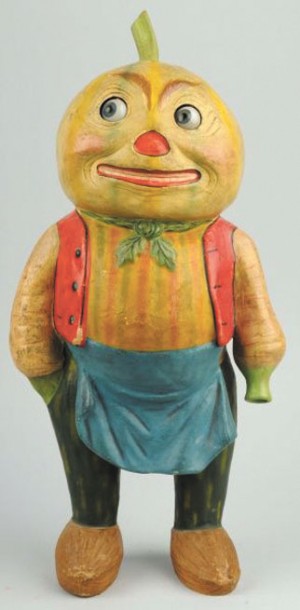Second in popularity only to Christmas as a holiday collectible, the memorabilia of Halloweens past is much more difficult to find. It is this scarcity of mint condition pieces that makes the collecting both challenging and rewarding.
The elegance of the late Victorian period in America provided the perfect setting for the celebration of Halloween. The elaborately decorated homes of the elite welcomed guests who spent the evening in full costume playing bridge, mahjong, and parlor games. Winners of these games, as well as those judged to be the best costumed, were given candy filled glass containers, noise makers and lanterns as prizes. Sadly, many of these were discarded come November 1st, but those that survived are a part of one of today’s most cherished holiday collectibles, Halloween Memorabilia.
From the golden era of Halloween memorabilia 1900-1930 come the most highly sought collectibles. Cardboard lanterns, postcards, sheet music, candy containers, witch dolls and party boxes rank as top finds. These early pieces, particularly those in good condition, are rare and valuable. At the top of the price range are fine German pieces made from 1919-1935 including lanterns and candy containers. The quantity of items produced during this time frame was quite small, and as with many collectibles, scarcity equals dollars.
Desirability in this field of collecting is largely determined by topic matter. In descending order of value we start with devil imagery, witches and vegetable people at the top, followed by black cats, skeletons, and owls, and lastly the pumpkin or its alter ego, the Jack-o-Lantern. Since Halloween items are notoriously hard to accurately date, a good rule is, the scarier the image, the older the item.
Halloween die-cuts from The Beistle Company and Dennison Manufacturing are among the most popular of the American-made Halloween collectibles. Research is a necessity in this line of collectible as the majority of these pieces, especially those from Beistle, are unmarked. As you acquaint yourself with the imagery and design of Beistle pieces, identification will become easier. One aid to recognizing and dating the work of Dennison Manufacturing are the “Halloween Bogie Books” printed from 1909-1935.
In the years between WWI and WWII many of the Halloween decorations sold in the U.S. were imported from Germany. Paper mache figures, candy containers, lanterns and “nodders” are especially appealing to collectors who are drawn to their faces, which are considerably more ghoulish and morbid than their American-made counterparts from that era.
One of the easiest decoration to find are tin noisemakers, due in part to the fact that they were the one item that was kept and reused from year to year. Thousand of these were produced by American firms in the 1920s and 1930s. Names to watch for include Bugle Toy, Chein, Kirchhof and T. Cohn. Tambourines, clangers, rattlers, ratchets and other tin pieces from the early years can be identified by their sculpted wooden handles.
As we entered the 1930s, “vegetable people” became the Number 1 must-have at any children’s party. These whimsical celluloid figures were made to be given out at as favors and at the end of the party they were crushed to “drive away evil spirits.” Those that survived are earning top dollar at specialized auctions.
American mass-produced pieces from 1960 forward flood the marketplace and are of little value. Reproduction is also an issue, especially those from the early years of the Beistle company. Read all you can, attend collector’s shows and seek the counsel of a knowledgeable dealer before laying down any serious money. Until next time…Linda
Linda Kennett is a professional liquidation consultant specializing in down-sizing for seniors and the liquidation of estates and may be reached at lkennett@indy.rr.com or 317-258-7835.



